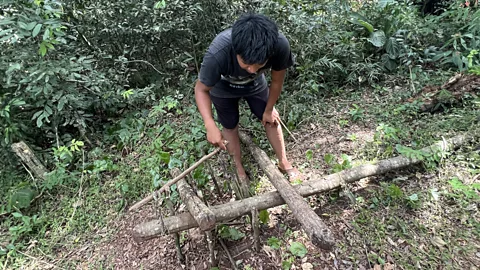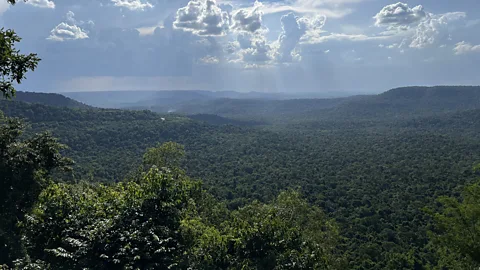The remote Argentinean community that is saving the stars
 Alejandro Sommer
Alejandro SommerIn the jungle of Misiones, Argentina's northern green thumb, one Indigenous community is working to save their ancient knowledge of the night sky.
"See this path of stars?" Domingo Moreira said softly, pointing up at the sky. "In Guaraní, it is called Mborevi Rape – the road of the tapir god."
It was a warm summer night and we were stargazing on a strip of sand at the centre of Iberá National Park, a wetland area in northern Argentina. There was no light pollution and the stars spread brightly across the sky, melting into Iberá's flat, marshy horizons.
"The tapir is a nocturnal animal that always walks the same path between its den and points of food or water," Moreira explained. "At night, the dry leaves trampled by the tapir shine in the moonlight. Our ancestors placed this shining path into the sky. In Spanish, you call it La Via Lactea (the Milky Way)."
Moreira is the second chief of the Yvytu Porá Guaraní, an Indigenous community of about 25 families whose lands fall within the jungles of what is now Argentina's north-eastern Misiones province. In recent years, the Yvytu Porá have been working to save and share their ancestral knowledge of the night sky. Surrounded by light pollution from Paraguay and Brazil, the largely rural and forest-covered Misiones – home to Iguazu Falls in the far north – is a corridor of darkness. It lies on the Guaraní peoples' ancestral lands.
Though most often associated with Paraguay, where Guaraní is one of the national languages, Guaraní communities have historically lived across a vast area of South America, mainly in what is now Paraguay, Argentina, southern Brazil and parts of Uruguay. At the height of the Spanish and Portuguese colonial invasions in the 17th Century, many Guaraní people were subject to slavery and Christian conversion by Jesuits, who had established a series of mission churches here. These would later give the modern-day province of Misiones its name.
Today, the Guaraní in Misiones have split into a variety of different groups and family units, many of whom live surrounded by nature in areas near the Paraná River, which forms the border between Argentina and Paraguay.
 Megan Eaves
Megan EavesThe stargazing evening I was attending is a visitor experience called Cielo Guaraní (Guaraní Sky), which is held regularly at dark locations in the region. During these events, Moreira shares his ancestors' stories of the stars and the Guaraní's traditional knowledge of the night sky with visitors. These range from the practical – such as night-time wayfinding using the Southern Cross constellation – to the spiritual – like how their grandparents travelled the Tape Kue (Old Road; another Guaraní name for the Milky Way) and how we will all return there one day.
The Cielo Guaraní project was developed together with Alejandro Sommer, a delegate for DarkSky International and founder of the organisation's Argentina chapter. Sommer, who hails from Misiones, is also the director of ecotourism for the provincial tourism authority. He is equally passionate about preserving his homeland's natural environment and amplifying and protecting the Guaraní way of life.
A few days earlier Sommer had taken me to visit the Aldea Yvytu Porá (aldea means "village"), a tidy collection of thatch-and-earthen homes that sits in the verdant Cuña Pirú Valley along a stream of the same name. Moreira greeted us with a jug of tereré, a cold infusion of fruit juice and yerba mate. This green tea-like plant, highly popular in Argentina and neighbouring regions, originated with the Guaraní. It is usually prepared with hot water and drunk from a traditional vessel made of a gourd or pumpkin. But during Misiones' blistering summers, the cold version is a refreshing alternative. Both mate and tereré are drunk from a shared cup and straw, which is passed around in turns.
As we were sipping, a group of men emerged from the forest carrying large chunks of honeycomb. They held it up and let me taste the fresh honey dripping warm from the comb, then passed around a bowl of boiled yuca (cassava) to dip in it. Along with basketry and woodcarving, beekeeping is one of the community's traditional livelihoods.
"The bees build their hives inside the tree trunks," Sommer translated for me, explaining that the melipona bee is a stingless species native to these Chaco jungles in Argentina. "To extract all the honey, they must eventually cut down the tree. The Guaraní feel it is not sustainable for the environment, so that's where ecotourism and astrotourism are becoming valuable for the community."
 Alejandro Sommer
Alejandro SommerWalking the eco-trail, a one-hour loop from the main village entrance, one of the community's nature guides showed me a traditional hut used for prayer and spiritual reflection and explained a variety of simple but clever traps. The Guaraní use these to hunt small birds and sustainably manage the more dangerous wildlife in the forest, such as snakes and jaguars. According to Juanita González, chief of the Yvytu Porá and one of only eight women Indigenous leaders in Misiones, the trail is the only one of its kind in the Cuña Pirú Valley. She told the Argentinean digital newspaper Infobae that the trail "allows [visitors] to learn and value the Mbyá Guaraní culture, wisdom and skills".
The Cielo Guaraní astrotourism events also started in 2017 and are most often held at Salto Encantado Provincial Park a few miles away from Aldea Yvytu Porá. These visitor experiences are helping the community preserve and disseminate their traditional sky knowledge and provide new income streams. The events involve a mix of Guaraní star knowledge shared by Moreira and Western astronomy explained by Sommer, as well as dinner and drinks in the provincial park's open-air restaurant overlooking the 64m-high Salto Encantado waterfall, which itself is the subject of a Romeo-and-Juliet-style Guaraní origin story about ill-fated lovers.
The events are integral to the community's ongoing nocturnal conservation efforts, which are aimed at eventually gaining certification as an International Dark Sky Reserve. Thanks in large part to Sommer's advocacy efforts, in 2022 Misiones enacted the Ley de Conservación del Cielo Oscuro y Promoción del Astroturismo (Dark Sky Conservation and Astrotourism Promotion Law), a provincial law that saw it replace its previous streetlights with warm-coloured, dark sky-friendly luminaires that are less harmful to the province's abundant flora and fauna.
 Megan Eaves
Megan Eaves"About 52% of Argentina's total biodiversity is within Misiones, which is actually only 1% of the country's total land area," Sommer said. "We also have water and soil protections in place," he said, referring to a 2010 land-use law that, according to the World Wide Fund for Nature (WWF), has brought more than 1.2 million hectares of native forest in the province under protected status.
"With a dark sky reserve, I believe Misiones could be the only place in the world so far that would have legally protected sky, soil and waters. That's why we're looking at darkness as a heritage resource," Sommer said.
Cielo Guaraní is one of a growing number of projects aiming to catalogue, preserve and promote Indigenous knowledge of the night sky around the world. Native Skywatchers is another, focused on the Ojibwe and D/Lakota communities in the US and Canada. In Australia, Duane Hamacher, associate professor of Cultural Astronomy at the University of Melbourne, is working with Aboriginal communities to document their ancestral star lore. His 2022 book, The First Astronomers, amplifies the work of six First Nations elders who have preserved Indigenous sky knowledge passed down within their communities.
More like this:
• The last places on Earth to see truly dark starry nights
Dr Aparna Venkatesan, a cosmologist and cultural astronomer at the University of San Francisco, is a leading researcher on how Indigenous voices are represented within astronomical science and in preserving space as a cultural resource. Together with light pollution researcher and astronomer Dr John Barentine, in 2023 she coined the term "noctalgia" to express the idea of "sky grief", or the feeling accompanying the loss of humanity's shared starry skies due to light pollution. Venkatesan says this loss is acute for Indigenous groups, whose millennia-old sky traditions have not been considered with humanity's rapid increase in artificial light at night.
 Alejandro Sommer
Alejandro Sommer"Space is our shared heritage and ancestor, connecting us through science, storytelling, art, origin stories and cultural traditions," Venkatesan told me by email. "Rapidly rising light pollution is erasing Indigenous stories and identities – again – as history is painfully repeated for marginalised communities."
At the end of my evening of stargazing with Moreira in the Iberá wetlands, he pointed to the Magellanic Clouds – which Western astronomy explains as two neighbouring galaxies visible in very dark places in the Southern Hemisphere. But the Guaraní cosmology he shared was full of different wisdom.
"The elders left two torches in the sky to know where we came from and where we are going," he said. "This is what I learned sitting around the fogones (firepits). The sky shows us the way and the ancestors watch over us. And the stars remind us that they will continue to take care of us as long as we are on this Earth."
--
If you liked this story, sign up for The Essential List newsletter – a handpicked selection of features, videos and can't-miss news, delivered to your inbox twice a week.
